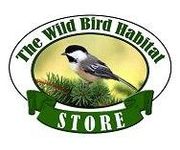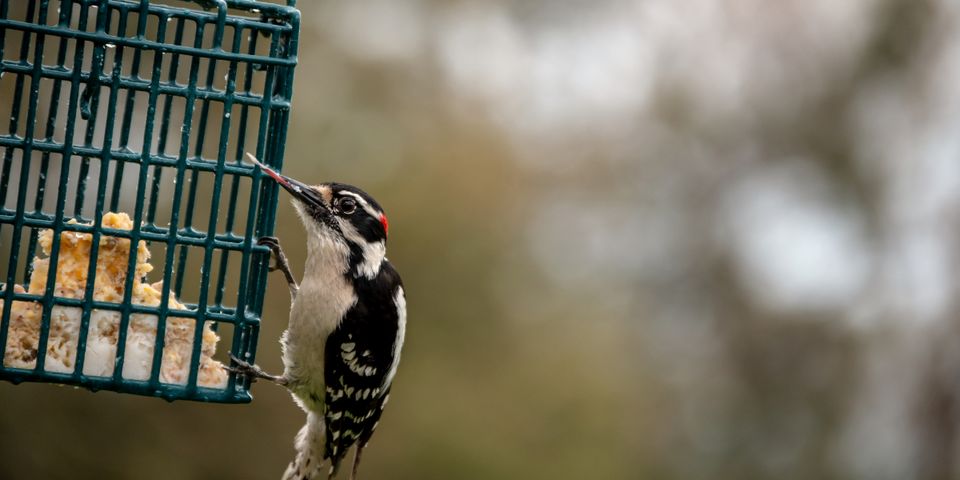
If you want to provide a high energy food source for birds of the tree trunk zone that visit your yard, installing a suet feeder is an excellent option. Suet attracts woodpeckers and nuthatches. Other birds attracted to suet include Chickadees and wrens. Although most people believe suet is a winter-time food for backyard birds, woodpeckers will consume more suet between March and the end of summer than they do all winter long.
Wingtip: Suet provides a high energy food for woodpeckers in the spring when insects are few. Attracting a mate, defending a territory, excavating a nest cavity, raising and feeding a family takes a lot of energy. Suet provides an excellent supplemental year round food source for all these activities.
What Is Suet? Suet is rendered animal fat. The rendering of the animal fat kills bacteria preventing the suet from becoming rancid. This animal fat is what attracts the woodpeckers and other birds to the suet feeder. It’s a great supplement for birds that flourish on insects.
Other products such as seeds, nuts, berries, and fruits are often added to the rendered animal fat. This adds a bit a variety to the suet for birds. However, when nuts and seeds are added to the suet mix it often gets the attention of squirrels and pesky starlings. It may also attract other unwanted birds such as grackles. If that is the case then feeding cakes of pure suet will alleviate unwanted birds as the woodpeckers and nuthatches are after the animal fat. Those added products are more of a treat for backyard birds.
The most common way suet is offered to birds of the backyard is in an 11 ounce square cake. But you can also get suet in plugs for suet logs, balls for specialty suet ball feeders, and nuggets that you can put in most wire mesh bird feeders. However, you feed suet, it is one of the 7 Basic Backyard Bird Feeders that attracts a specific group of birds.
Wingtip: Most suet cakes can be used in suet feeders year round including summer. However, if your suet feeder is located in the hot summer sun you may want to use suet cakes listed as ‘suet dough’. They will not melt even under extremely hot conditions.
TYPES OF SUET FEEDERS
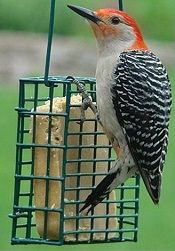
Standard Wire Suet Baskets - Suet bird feeders for the 11 ounce suet cakes can be a simple wire suet basket you insert the suet cake into. It may be a wooden feeder with a tail prop (a wooden extension where the woodpecker braces its tail for leverage) It may be a covered feeder where the suet is only exposed and accessible from the bottom (woodpeckers, nuthatches, wrens and Chickadees are clinging birds and can cling from the bottom to feed. This deters most all unwanted birds) And if squirrels and unwanted birds continually raid the suet, the suet basket may be wrapped in a cage.
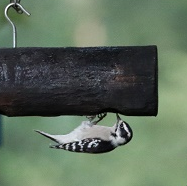
Suet Log Feeders - Suet logs are generally 12 to 16 inches long and have holes drilled through them that suet plugs are packed into. This provides a very natural type suet feeder for woodpeckers where they can use their tail against the log for leverage as they feed. Some suet logs only allow birds that can cling to feed from the bottom. ATTRACTOR SUET LOGS / ATTRACTOR SUET PLUGS
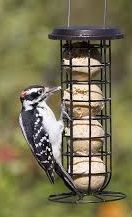
Suet Ball Feeders – Suet ball feeders come in a variety of shapes and sizes from straight to circular. The suet balls are just dropped into the feeder and hung up.
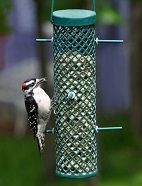
Suet Nugget Feeders – Suet nuggets are processed into ¼” pieces of suet in a variety of recipes. Some of those recipes include dried meal worms. Any mesh bird feeder such as peanut feeders or sunflower mesh feeders will hold the suet nuggets. No perches are necessary as the birds you are attracting, woodpeckers, nuthatches, wrens and Chickadees are clinging birds.
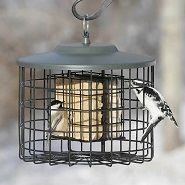
Caged Suet Bird Feeders – These are generally a typical wire basket which holds one or two 11 ounce suet cakes. The cage protects the suet from squirrels, raccoons, and starlings. Downy Woodpeckers, nuthatches, Chickadees and wrens can easily enter the cage to feed. Larger woodpeckers can reach in and extract the suet with their long tongue that is barbed and sticky on the end.
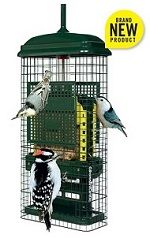
Brome Squirrel Proof Suet Bird Feeder – Brome Bird Care offers a full line of high quality functional squirrel proof bird feeders. They now offer a squirrel proof suet bird feeder that takes the 11 ounce suet cakes. The design of the feeder allows birds to readily feed on the suet but closes from the weight of a squirrel restricting their access. Brome squirrel proof bird feeders are fully warranted. BROME SQUIRREL PROOF SUET FEEDER
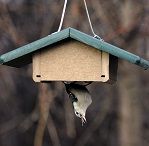
Upside Down Suet Feeders - work well to deter unwanted birds such as starlings from sitting on top the suet feeder to feed. The suet is only exposed on the bottom with the top covered by a roof. Woodpeckers, nuthatches, Chickadees and wrens can easily cling upside down to get the suet.
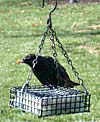
Turn any simple wire suet basket into an upside down suet feeder with the Starling Stumper. Unwrap the suet cake leaving the plastic shell on the suet. Slide the suet cake with the plastic shell into the suet basket. Attach the three chains of the Starling Stumper to the basket and hang. You can also use the chain that comes with a suet basket to hang the suet feeder upside down. Just remember to leave the hard plastic shell on the suet when you slide the cake into the suet basket. This prevents unwanted birds from sitting on top the suet feeder to get the suet since they cannot peck through that plastic cover.
If you are in the Lincoln, Nebraska area, or passing through, stop by the Wild Bird Habitat Stores where we offer the areas largest selection of suet bird feeders, suet cakes, Attractor suet plugs, suet balls, and suet nuggets. You can also find some of the more popular suet products online at SUET BIRD FEEDERS and SUETS.
When you want to purchase a suet feeder or other bird supplies, contact Wild Bird Habitat Store in Lincoln, NE. This family-owned and -operated business has been serving bird-lovers in the area for over 25 years. In addition to selling birding supplies, they provide educational resources to support the local birding community and general conservation efforts. Visit the website to view their products, and call (402) 420-2553 to speak with a team member about your needs.
About the Business
Have a question? Ask the experts!
Send your question

